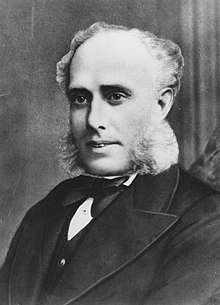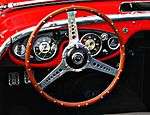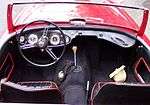Smiths Group
|
Bringing technology to life | |
| Public limited company | |
| Traded as |
LSE: SMIN FTSE 100 Component |
| Industry | Engineering |
| Founded |
1851 (London) |
| Founder | Samuel Smith |
| Headquarters | London, United Kingdom |
Area served | Worldwide |
Key people |
Sir George W. Buckley (Chairman) Andrew Reynolds Smith (CEO) |
| Products |
Detection sensors Mechanical seals (wet seals and dry gas seals) Couplings Hydrodynamic bearings Filtration systems Medical devices Electronic components Heating and ducting systems |
| Revenue | £3,280 million (2017)[1] |
| £589 million (2017)[1] | |
| £572 million (2017)[1] | |
Number of employees | 22,000 (2017)[2] |
| Divisions |
John Crane Inc., Smiths Medical, Smiths Detection, Smiths Interconnect, Flex-Tek |
| Website | www.smiths.com |
Smiths Group plc (LSE: SMIN) is a British multinational diversified engineering business headquartered in London, United Kingdom. It has operations in over 50 countries and employs around 23,550 staff.
Smiths Group has five divisions. Smiths Detection is the world's largest manufacturer of sensors for the detection of explosives, weapons, chemical agents, biohazards, narcotics and contraband.[3][4] John Crane is a manufacturer of seals and associated products for the process industries.[4] Smiths Medical is a manufacturer and supplier of specialty medical devices and equipment.[4] Smiths Interconnect is a manufacturer of electronic and radio frequency components.[4] Flex-Tek is a supplier of components to heat and move fluids and gases.[4]
Smiths Group is listed on the London Stock Exchange and is a constituent of the FTSE 100 Index.
History
S Smith & Sons

The watch chronometer and instrument retailer's business was established by Samuel Smith as a jewellery shop at 12 Newington Causeway in south east London in 1851. The firm moved the centre of its operations to 85 The Strand in 1872, next door to the premises of Charles Frodsham. A large business operating as diamond merchants emerged in 1885, based at 6 Grand Hotel Buildings, Trafalgar Square, and from 1895 at 68 Piccadilly.[5]
The firm supplied high quality precision watches to the Admiralty, typically made by Nicole Nielsen of Soho Square. Retailing and wholesaling of Smiths-branded motor accessories was added in 1904 when Nicole Nielsen produced Smiths' initial speedometer, the Perfect Speed Indicator, the first of which was delivered to Edward VII for the Royal Mercedes. Nicole Nielsen had to open a new factory in Watford in 1907 to keep up with demand. Growth was fast. Smiths began to manufacture some of their own motor products particularly speedometers. From mid-1913 all motor accessories activities were carried out from handsome purpose-built premises at Speedometer House, 179-185 Great Portland Street ("Motor Row").[6] The premises in the Strand became a Lyons tearoom but the jewellers establishments were retained at Trafalgar Square and 68 Piccadilly. By this time motor accessories production included Smiths multiple-jet carburettors (designed by Trier & Martin), lighting sets, headlamps, sidelights, tail lights, dynamo and electric starters, generators and the Smith's Auto-Clear mechanical horn.[7]
The outbreak of war in 1914 led to the capture of markets around the world previously held by the German competition. By 1915 new War Office contracts for aeroplane accessories, lighting sets etc. and munitions required the speedy erection of a new freehold factory. The new factory, known as Cricklewood Works, was built at Cricklewood, north London.[8] In 1921 Great Portland Street activities were moved to Cricklewood following 1920's purchase of the former Metallurgique works alongside their Cricklewood Works.[9] Post World War I their accessories became standard fittings in new cars all provided by the manufacturer.[10]
First half of 20th century
_(cropped).jpg)
At the start of the 20th century, the age of the early automobiles, Smith & Sons retailed one of the first British odometers ("mileometer") and speedometer.[11] In the 1930s Smiths agreed a trading deal with Lucas whereby the two would not compete in certain areas and Lucas took on part of Smiths non-instrumentation assets.[12]


Smiths became the dominant supplier of instruments to British motorcar and motorcycle firms.[13] These later 20th century instruments carried a distinctive logo, the word "SMITHS" centred above the middle of the dial and silk screened onto it in a unique house font familiar to generations of drivers.[14]
The KLG Sparking Plug distribution rights were purchased from Kenelm Lee Guinness in 1919. Smiths purchased 75 per cent of Ed. Jaeger (London) Ltd in 1927 (which became British Jaeger Instrument Company in 1932). Also in 1927, Smiths purchased the KLG Sparking Plug Company (Robinhood Engineering).[15] The Jackall hydraulic jacking system was manufactured from 1935 by Smith's Jacking Systems and immediately became standard equipment in many popular cars. In 1937 a separate aircraft and marine department was created in the parent company and named Smiths Aircraft Instruments. It operated with Smiths subsidiary Henry Hughes and Son manufacturers of aircraft and marine instruments.[16] In 1946, Smiths and the Ingersoll Watch Company founded the Anglo-Celtic Watch Co. Ltd., which produced watches in Wales. This became one of the largest producers of watches in Europe before closing in 1980.[17]
Second half of 20th century
Separate Smiths Aviation and Smiths Marine divisions were set up in 1958.[11] In 1960, an Industrial division was formed whose main operations were industrial instrumentation.[11] With increasing diversification and international operations the name Smiths Industries Ltd was adopted in 1967[18] when the advertised product range was: automotive — aerospace — marine — building — medical — clocks — watches — appliance controls — industrial instruments — ceramics — electronics.[19]
Clocks, watches, and automotive instruments eventually ceased to be significant markets for Smiths,[11] and by the 1980s, the automotive instrument division had been sold,[11] first to Lucas, and eventually to the factory employees. The new company, Caerbont Automotive Instruments, continues to produce classic Smiths-branded instruments with the blessing of Smiths Group plc.[20]
21st century
The company's name was changed to Smiths Group plc on 30 November 2000[21] and on 4 December, Smiths completed a merger with TI Group. TI had interests in aerospace, industrial seals and automotive parts.[22] However Smiths divested TI Automotive shortly after the merger.[23] In 2007 GE Aviation, a division of General Electric, acquired Smith's aerospace subsidiary, Smiths Aerospace, for US$4.8 billion.[24]
In September 2011 Smiths Group acquired the United States-based power technology enterprise, Power Holdings Inc., for £145 million.[25] It was announced on 21 April 2016 that Smiths Group will be acquiring Morpho Detection LLC, a US-based subsidiary of Safran, as part of Smiths Detection division.[26]
Operations
Following an enterprise-wide restructuring programme in mid 2008, Smiths Group is organised into five separate divisions, namely:[27]
Smiths Detection
Smiths Detection designs and manufactures sensors that detect and identify explosives, weapons, chemical agents, biohazards, nuclear and radioactive material, narcotics and contraband. These sensors are widely used in airports, cargo screening at ports and borders, in government buildings and other critical infrastructure, as well as by the military and emergency responder services. The business uses a wide range of technologies including x-ray, trace detection, millimetre-wave, infra-red, biological detection and diagnostics. The business also carries out research to develop advanced technologies and introduce new products to combat terrorism and the illegal passage of goods.
Smiths Medical
Smiths Medical makes specialty medical devices for infusion therapy, vascular access and vital care and other specialty products and services. Their devices are found in hospital, emergency, home and specialty care environments and are used during critical and intensive care, surgery, post-operative care and for support in managing chronic illness.
John Crane
John Crane provides products and services for the major process industries, including the oil and gas, power generation, chemical, pharmaceutical, pulp and paper and mining sectors. Products include wet seals, gas seals, couplings, seal support systems, specialist filtration systems, hydrodynamic bearings, and equipment for upstream applications.
Smiths Interconnect
Smiths Interconnect designs and manufacture products that connect, protect and control critical systems for the various markets.
Flex-Tek
Flex-Tek supplies of engineered components that heat and move fluids and gases for various markets.
Management
In 2015, Smiths appointed Andrew Reynolds Smith its CEO. Smith replaced Philip Bowman. Immediately before joining Smiths, Smith was CEO of GKN Automotive. He started work at GKN in 2002. He has worked in senior management at Ingersoll Rand, Siebe and Delphi Automotive Systems.[28]
References
- 1 2 3 "Annual Report 2017" (PDF). Smiths Group. Retrieved 17 March 2018.
- ↑ "About Smiths Group". Smiths Group. Archived from the original on 23 January 2016. Retrieved 12 April 2017.
- ↑ Pirone, Sabine (28 September 2011). "Smiths Profit Holds Steady Amid 'Constrained' Markets". Bloomberg. Retrieved 28 September 2011.
- 1 2 3 4 5 "DealTalk: Medical bid may herald long-awaited Smiths break-up". Reuters. 18 January 2011. Retrieved 28 September 2011.
- ↑ The Times, Friday, 7 August 1914
- ↑ "The Smith Office Building". The Office Group. Retrieved 17 March 2018.
- ↑ Prospectus. S. Smith & Sons, Limited. The Times, Tuesday, Jul 21, 1914; pg. 20; Issue 40581
- ↑ S. Smith & Sons (Motor Accessories), Limited. The Times, Thursday, Sep 09, 1915; pg. 11; Issue 40955
- ↑ S. Smith & Sons (M.A.) Ltd. The Times, Friday, Feb 25, 1921; pg. 9; Issue 42654
- ↑ Company Results. The Times, Thursday, Nov 26, 1931; pg. 21; Issue 45990
- 1 2 3 4 5 "Smiths History". Smiths-medical.com. Retrieved 19 April 2011.
- ↑ "History of Lucas" (PDF). UK Competition Commission. Archived from the original (PDF) on 26 July 2011. Retrieved 12 April 2017.
- ↑ Pook, Les (2015). British Domestic Synchronous Clocks 1930-1980: The Rise and Fall of a Technology. Spring. p. 28. ISBN 978-3319143873.
- ↑ gibgo12. "Re: Smiths speedometer font?". BritBike Forum. Morgan Johansson. Retrieved 13 January 2015.
- ↑ S. Smith And Sons (Motor Accessories). The Times, Friday, Dec 09, 1927; pg. 23; Issue 44760
- ↑ S. Smith & Sons (Motor Accessories). The Times, Friday, Nov 19, 1937; pg. 24; Issue 47846
- ↑ "Anglo-Celtic Watch Co. Ltd. 1".
- ↑ "Smiths Industries Ltd". National Archives. Retrieved 12 April 2017.
- ↑ Smiths Industries. The Times, Friday, Jan 07, 1966; pg. 7; Issue 56523
- ↑ E-comservices. "Caerbont Automotive Instruments". Caigauge.com. Retrieved 19 April 2011.
- ↑ Proposed Merger of Smiths Industries plc: "Smiths Industries" and "TI Group" Business Wire, 17 November 2000
- ↑ "Engineering rivals to merge". BBC News. 18 September 2000. Retrieved 25 September 2006.
- ↑ TI Group plans to sell off auto suppliers
- ↑ "Smiths Agrees to Aerospace Sale." Singer, J. The Wall Street Journal. 15 January 2007.
- ↑ "Smiths Group buys specialist US power provider for £145m". This is Money. 2 September 2011. Retrieved 12 July 2012.
- ↑ "Smiths Group to Boost Security Business With Purchase From Safran." Wall, R. The Wall Street Journal. 21 April 2016.
- ↑ "Our business". Smiths Group. Retrieved 12 April 2017.
- ↑ "Smiths Group appoints GKN's Andrew Reynolds Smith as CEO". The Telegraph. 7 July 2015. Retrieved 12 April 2017.
External links
| Wikimedia Commons has media related to Smiths Instruments. |
Further reading
- Nye, James (2014). A Long Time in Making - The History of Smiths. Oxford University Press. ISBN 978-0198717256.